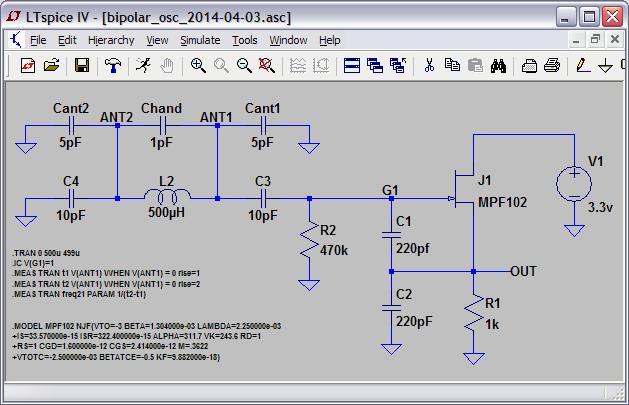"I am a bit surprised by the effect you are getting from a "distant" oscillator - If the distant one was driving a series LC resulting in a high antenna voltage, and was affecting one with low antenna voltage, I could see it.." - FredM
Relatively measured just now through a 1pF series cap, the antenna voltages are 4V (bench osc) and 2.6V p-p (hand held osc) with a 8pF / 10Meg probe. They weren't sharing a ground or a scope or a power supply for the first distance test. This kind of disturbance bothers me the least because the frequency has to be pretty much spot on to have any effect at all (that I could see on the scope). I'll have to try it again with a common ground as this would reflect reality better.
"Also, 6% is not "close" by any theremin standards - at 100kHz, thats a full 6kHz.. At 250kHz thats well outside the maximum difference one gets on say an EW.."
It is close by Theremin standards in the sense of pitch and volume oscillator operating points - e.g. for the EWS this difference is almost an octave (260kHz and 450kHz respectively). I need to experiment more (story of my life) but it seems clear that one can have three oscillators & antennas on a Theremin as long as they are sufficiently far enough apart in terms of distance / frequency (which is a trade-off; and which seems self-evident in retrospect). For two volume antennas placed very close together this might require a 25% difference in frequency or more, for the more distant pitch antenna one might also go with something in the 25% range as well since it is controlling something more perceptible to our human senses.
I'm doing these tests in the 1.7MHz range because that's the coils I have handy at the moment. Ideally I'd like to be running them in the 2-3MHz range like livio suggested in order to avoid strong broadcasts and such, and this almost works mathematically. Divvying this up geometrically into three (3/2)^(1/2)=1.225 or 22.5% zones gives 2, 2.45, and 3MHz. These obviously can't be set exactly due to the vagaries of bulk antenna capacitance so some additional slack is likely called for.
And who knows what subtly audible effects might creep into all this, though I intend to heterodyne above 1kHz and average / comb filter to some degree. I can see why other non-Theremin but essentially Theremin projects with multiple sensors immediately jump on a single stimulus / synchronous detection scheme as it makes a lot of sense from an internal interference perspective. I need to look at them further I suppose, but they somehow seem inherently AM & RC to me. And after reading some of Self's "Small Signal Audio Design" (thanks for that pointer Fred!) I rather suspect the use of premium opamps for all of the functionality going on. If one lowly Radio Shack JFET with a simple hand wound coil can do the same thing, maybe frequency division rather than code division is the better way to go?
(And it's not like any of these projects are in any real sense actually using multiple code division among the sensors - they talk it up with a bunch of sexy sounding language, but in the end they use a single code to scramble and average out environmental interferers. If they only use a single code, how immune can they be to conducted crosstalk between hands? If they were to use multiple orthogonal codes (i.e. Gold codes) they might need some mechanism to make the received power at each antenna roughly the same, something I believe may be impossible with multiple closely spaced receivers.)
Anyway, I have a new respect for the placement of several Theremins in the same room!


